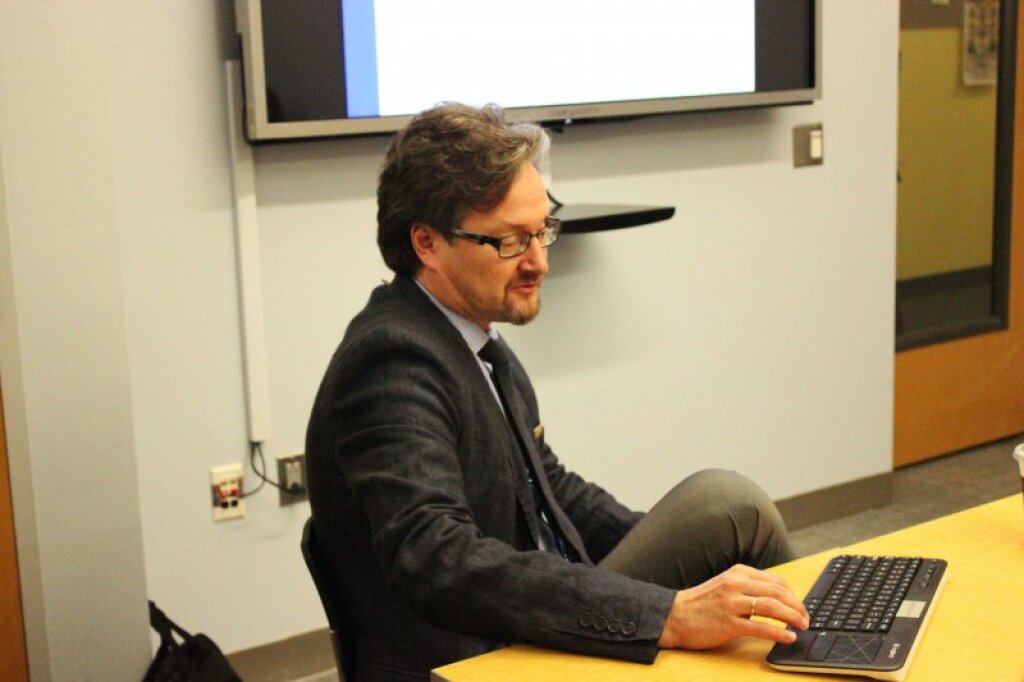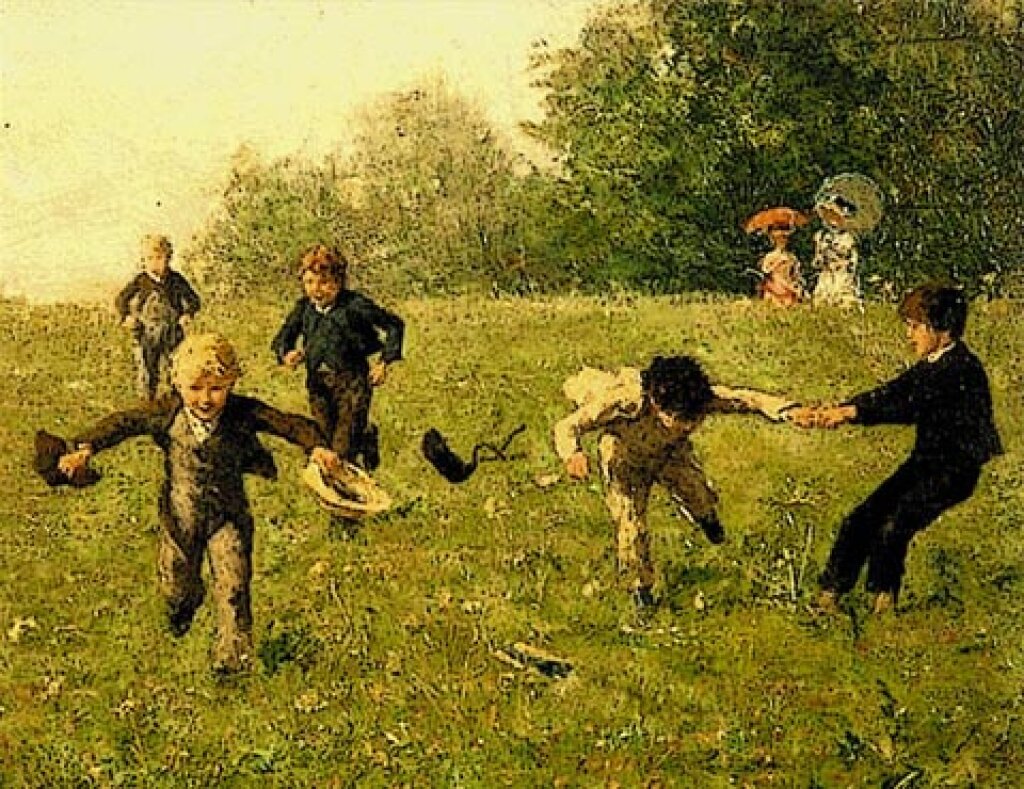Watch the video of the event here
On October 15, 2014, the Jordan Center welcomed Oleg Kharkhordin with a lecture entitled “A Point of Order! The Troubled Travels of Robert’s Rules of Order from America to Russia, or How Russians Tried to Invent Order Themselves.” Oleg Kharkhordin is a political sociologist and the the Rector of the European University of St. Petersburg, which, as Director Yanni Kotsonis stressed in his introduction, is an institution with a remarkably high concentration of brain power and quality.
Kharkhordin began his talk by explaining that his presentation is the result of the research that he carried out on contemporary Russia, its municipalities and self-governing communities. Kharkhordin was interested in comparing activist groups like Zhivoi gorod (Live city), which tries to protect and preserve historic St. Petersburg, to activist groups that appeared in the early days of the Perestroika period. Analyzing the similarities between various activist groups led Kharkhordin to write an article that attempted to answer the question of why Russians are often unable to organize efficiently. He observed that in various meetings, the negotiating groups reveal two polarizing discursive practices. They either adopt a sentimental and passionate rhetoric, which impedes productive discussions and often simply results in an exchange of heated insults; or they adopt a language that is too official and reminiscent of Soviet-style negotiations, which also produces no concrete results. Kharkhordin concluded that in the case of Russian discursive practices of negotiation, the middle ground is decisively absent and that “we, as social scientists, wanted to think of how we could help groups like this find the proper and effective language.”
“The answer exists in America,” Kharkhordin asserted. And that answer is Robert’s Rules of Order – a book written by U.S. Army Colonel Henry Martyn Roberts. Its first edition came out in 1876 under the full title of Pocket Manual of Rules of Order for Deliberative Assemblies. This came to be the primary text used as a manual for parliamentary procedures in the English-speaking world. “I learned of the book only when I moved from democratic [University of California,] Berkeley to aristocratic Harvard,” Kharkhordin remarked. “It was recommended to me there, and only after having sat through many unruly meetings in Russia I realized that I have to read this book. Now I tell them that there is a hidden structure behind the ‘ruly’ meetings in the States.”
Kharkhordin added that for Russians, it is still a big discovery that a book on discursive rules even exists. What seems peculiar to them in meetings organized according to these rules, Kharkhordin continued, is the appeal to politeness and decorum. Similarly, the rhythm of the proceedings (“I rule. I second.”) seems foreign and surprising. From the Russian perspective then, all of these rules are just an unnecessary complication.
“So why all this formalism?” Kharkhordin asked rhetorically in connection to Western proceduralism. Thomas Jefferson and other American politicians relied on centuries of practice that were worked out in the English Parliament, he noted, seeming to imply that it is the existence of tradition and the maturity of civilization that allow a nation to develop formal and effective parliamentary procedures. He continued by ironically remarking that if it took 300 years to civilize the British lords, how long will it take to civilize the Russian groups who might have had a beer or two before coming to the meeting?
“Can we copy the procedure of the Americans and the Brits?” Kharkhordin wondered. There are five hundred years of tradition of growing to democracy in the West. “If we want to do it faster,” he stated, “we need a list of procedures.” The implementation of Robert’s Rules of Order in the U.S. helped to conduct meetings with people of different confessional backgrounds. It also proved effective in Quebec, where immigrants from different cultures had to learn how to negotiate. Kharkhodin remarked that the idea of implementing Robert’s Rules of Order in Russia was greeted with skepticism in the past. Two translations of this text were brought in by the Americans during Perestroika in order to “civilize the brutes.” But “there are two things that would make a Russian life better: Prozac and that stuff,” Kharkhordin remarked, “you smile and you fall asleep.”
Kharkhordin advocates a new translation of the text in Russian. However, “why do it unless you have people who will use it?” he asked during the lecture. Even if a shorter version of the text was translated, it would need to be more culturally specific: “If we want [it] to be used we have to understand what [the] practices and intuitions that Russians share [are]. And what practices are they used to? What are they? We don’t know yet.” For example, Kharkhordin remarked that in contemporary Russia, the young people are not taught negotiation skills at all, noting that during the Soviet period, the older generations at least had the experience of learning procedural rules in Komsomol meetings.
Next, Kharkhordin moved on to speak about the historical background of parliamentary proceduralism in Russia. The attempt to implement stricter procedural rules in Russia had been done before. For example, the parliamentary procedures proposed in the 1907Order of State Duma by Sergei Muromtsev and Moisey Ostrogorsky (Nakaz Gosdumy Muromtseva-Ostrogorskago) proved efficient if not long-lasting; some of its suggestions have been partly implemented by the Bolsheviks, Mensheviks and Socialist-Revolutionaries, among others. With time, however, the emphasis on politeness was overturned together with the rights of the minorities. Making a cynical remark and briefly refocusing on Russia’s contemporary politics, Kharkhordin stated: “[Members of Russia’s 1917 Provisional Government Vasily] Maklakov and [Aleksandr] Kerensky wanted to defend the rights of the minorities. In the beginning 30 could veto the majority vote. But then with time, 30 became 50, 50 became 100, and then it became United Russia.”
Kharkhordin cautioned against thinking that the Americans were successful at their parliamentary proceduralism from the very beginning. “The right to appeal was completely prohibited by Jefferson.” Only after the Civil War, both the House of Representatives and the Senate instituted a right of appeal. But it did not exist right away. Once again, stressing the evolutionary nature of successful proceduralism, Kharkhordin remarked, “It required tradition, education, maturity.”
“The Russians were moving there, but then the revolution stopped it,” Kharkhordin continued. In the Bolshevik assemblies, the strict proceduralism was often seen as a bourgeois formality. For example, Georgii Plekhanov often questioned whether the Party assembled to play these procedures or to build a socialist revolution. The Party and Komsomol meetings refocused on elevating the souls of its participants rather than going through the trouble of strict implementation of rules. Therefore, with time, the Soviet regime gradually abandoned its strict proceduralism. And in post-Soviet Russia, the politicians were often too concerned with staying in control rather than concerning themselves with the official procedures.
After outlining the historical circumstances that led to the critical situation in contemporary Russia, Kharkhordin suggested a plan of action. First of all, it is important to research the general intuitions and attitudes towards proceduralism of people in Russia at our particular moment. It is essential to conduct sociological and historical research on group dynamics and meetings. Who might be at all interested in trying to play by these rules?
Following the talk, Kharkhordin elaborated on several questions and comments from the audience. Drawing on two paintings by Ilya Repin – “Reply of the Zaporozhian Cossacks” and “Ceremonial Sitting of the State Council on 7 May 1901 Marking the Centenary of its Foundation,” Professor Yanni Kotsonis remarked that these two works reflect the perceived opposites between the Western bourgeois parliamentarism and Slavic democracy, characterized by vitalism and life. These binaries, Kotsonis suggested, reflect those with which Kharkhordin plays in his research. Kharkhordin replied that in his opinion, the criticism of bourgeois parliamentarism is not necessarily Slavic.
Another comment from the audience seemed to suggest that the problem of “disorder” in Russian proceduralism is the result of a higher level of informal speech that is characteristic of Russian society. In reply to this comment, Kharkhordin cautioned: “We should not become cultural essentialists. One thing that I tried to articulate is the need for the study of different registers of speech. One register we don’t find is the public register. We find that historically, there were attempts to establish it but then the revolution killed it. The story is that we feel an absence of it. Is it a good thing? I don’t know. Maybe it is a blessing in disguise.”
Professor Boris Groys from the department of Russian and Slavic studies at New York University stated that this presentation reminded him of the ideas of Russian philosopher Mikhail Bakhtin. In his theory of dialogue, it is impossible to differentiate between an idea and person and it is not possible to come to any conclusions; dialogue is infinite by definition. In the context of modernity, Bakhtin is the only one who speaks of the impossibility of consensus. In a way, Russian culture is based on this idea, Groys observed. At the same time, the Russian culture also attempts to expose the Western types of Marxism, Nietzscheism, etc. as illusions. Kharkhordin replied that these elements found in Bakhtin’s thoughts, and further developed by Jacques Derrida, are increasingly becoming the character traits of the Russian soul and nationalism. He once again revealed his desire for Social sciences to affect positive change in daily life: “this proposal of reading Bakhtin as conditioned by his Russian background is very appealing. Whether it helps us to do something in everyday life is another question.”



